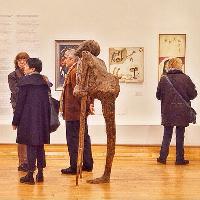The For the Democratization of Art Collections contains six photographs representing the activist work (i.e. performances) of the Croatian conceptual artist Marijan Molnar from 1979 to 1983. The work consists of a series of performances in which the author drew graffiti and hung banners with the message "For the Democratization of Art" in Zagreb, Belgrade and Ljubljana, collected signatures for a 'petition' on Republic Square in Zagreb, had his picture taken dressed as a terrorist for the student newspaper and presented an installation at the Koprivnica Gallery. Through this work, Molnar tried to point out the influence of politics on art in socialist Yugoslavia, at the same time seeking freedom of action for artists.
-
Vieta:
-
Zagreb Avenija Dubrovnik 17, Croatia 10000
-
Temos:
-
Įkūrimo data:
-
Charakteringi eksponatai:
-
Molnar, Marijan. Banner on SKUC building, 1981. Performance
-
Molnar, Marijan. Collecting signatures on Republic Square in Zagreb, 1979. Performance
-
Molnar, Marijan. Graffiti and banner in Belgrade, 1981. Performance
-
Molnar, Marijan. Graffiti in the underpass in Novi Zagreb, 1981. Performance
-
Molnar, Marijan. Photograph in 'Student Newspaper’, 1981. Performance
The temporary collection "Forms of Resistance" is dedicated to the artistic opposition against the communist regime in Bulgaria from 1944 to 1985. The exhibition highlights different forms of repression against particular artists at particular moments during the period of state socialism. It also shows the active role of some painters, as well as their forms of resistance against the dogmas of Socialist Realism and against ideological guidance. The upper time limit is the beginning of the perestroika in the Soviet Union, which marks the beginning of the final disintegration of the system of state socialism, also with regard to the political control of arts.
-
Vieta:
-
Temos:
-
Įkūrimo data:
-
Charakteringi eksponatai:
The collection reflects the activity of the architect Gheorghe Leahu, known in Romania for his watercolours representing streets and monuments of Bucharest destroyed as a result of the “urban systematisation” policy of Ceauşescu’s regime. The Gheorghe Leahu Collection includes watercolours, drawings, manuscripts, letters, photographs, and books.
-
Vieta:
-
București Bulevardul Libertății 12, Romania 030167
-
Temos:
-
Įkūrimo data:
-
Charakteringi eksponatai:
The informal group of the Six Artists consisted of Raša Todosijević, Era Milivojević, Marina Abramović, Zoran Popović, Neša Paripović and Gergelj Urkom. The work of these artists began with the establishment of the Student Cultural Center in Belgrade in 1971. It lasted to 1973, when each of them started working independently. Their artistic activity was above all a resistance to the existing practice that was being taught in the framework of school programs at the Academy of Fine Arts in Belgrade. They advocated the establishment of a modern approach to the reconstruction and functioning of artistic institutions, as well as to redefining the effects of art. The accent started to be set on the artist as a subject and to his authorial speech, "speech in the first place". The artists began to introduce new media into art (installation, bodybuilding, photography, film, text ...).
-
Vieta:
-
Temos:
-
Įkūrimo data:
-
Charakteringi eksponatai:
The digital photography collection of Harald Hauswald was acquired at the end of 2017 by the Federal Foundation for the Reappraisal of the SED Dictatorship. It represents a valuable collection from one of the most significant photographers from the GDR. Hauswald’s snapshots from everyday life in East Berlin provide insight into a bygone era, and which acquired public acclaim and support following the toppling of the regime in 1990. The current collection is in the process to be expanded and by the end of 2019 is expected to include the photographer’s entire life work in digitalized form.
-
Vieta:
-
10117 Berlin Kronenstraße 5
-
Temos:
-
Įkūrimo data:
-
Charakteringi eksponatai:





